- Home
- Michael Newton
The Texarkana Moonlight Murders: The Unsolved Case of the 1946 Phantom Killer Page 7
The Texarkana Moonlight Murders: The Unsolved Case of the 1946 Phantom Killer Read online
Page 7
“Of course, Betty Jo had a lot of boy friends,” she added. “But none were serious. She wasn’t in love. There was nothing serious in them—just about school and things like that. I’ve known Paul Martin for years. I believe they were forced to go to the park Saturday night. I think that because I know Betty Jo.” As for the authorities and the Phantom, she said, “I trust the men who are handling the investigation into my daughter’s death. I’m sure they’ll find whoever did it. If he is caught, I would like to kill him. If they would let me, I would kill him myself.”69
Approaching Easter Sunday, April 21, Texarkana was tense in anticipation of another attack. On the preceding Saturday, nineteen local clergymen signed a petition to both Texarkana city councils, demanding imposition of a curfew. It read:
WHEREAS this situation has existed in Texarkana for some time which is unfavorable for the proper and due observance of the Christian Sabbath in keeping open public amusement places until an early hour Sunday morning, and
WHEREAS this situation has further contributed to an increase in juvenile delinquency and crime in our community,
THEREFORE, be it resolved the Texarkana Ministerial Alliance petition the city councils of Texarkana, Ark., and Texarkana, Texas, to adopt an ordinance to close all public places of amusement on Saturday evening at twelve o’clock midnight.70
Even as the ministers appeared to blame the Phantom’s victims for their own demise, other self-appointed guardians of teenage virtue argued for a nine o’clock curfew. Hayes McClerkin, Jr., a ninth-grader who would later serve as Speaker of the Arkansas House of Representatives, told the Gazette, “I think the curfew is a good idea, but I did think it should be later on weekends—at least until 10 or 10:30 P.M.”71 On April 22, despite calls to close it entirely, the local Teen-Canteen announced that it would open at 7:00 P.M. as usual, but would close its doors at 10:30, a half-hour earlier than normal. Adult watchdogs grudgingly agreed, in hopes that a central rallying point would prevent young lovers from ranging farther afield.72
April’s end brought fear and hope in equal measure. Four local teens were reported missing on Monday night, the twenty-ninth, immediately sparking apprehension that the Phantom had resurfaced with a vengeance. Sheriff’s deputies and Texas Rangers scoured Bowie County in vain, before the youths returned at 3:00 P.M. on Tuesday. Their car had bogged down in mud, they explained, and they had waited out the night before starting a nine-mile trek back to town.73
On the same day that the missing teens resurfaced, word arrived from Corpus Christi, Texas, concerning a possible suspect in custody. The drama had begun on Thursday, April 25, when a thirty-year-old man entered a local music store and asked the clerk if she would care to buy an E-flat alto saxophone. The clerk replied that she would have to ask her boss, whereupon the stranger left abruptly. With Betty Booker’s missing instrument in mind, the manager summoned police and reported the incident. Police Chief S. O. Hamm and Detective Lieutenant Ike Ellis scoured the neighborhood, learning that a man of similar appearance had purchased a .45-caliber pistol from a nearby pawn shop. They traced him to a waterfront hotel on Saturday and took him into custody. No saxophone was found in his possession, but the officers retrieved a small bag containing items of bloodstained clothing. The man claimed it was his blood, from a recent barroom fight. After the music clerk identified him as her skittish customer, Chief Hamm notified Captain Gonzaullas in Texarkana.74
Gonzaullas dispatched Ranger Joe Thompson to question the suspect. Bad weather delayed Thompson’s flight, but he reached Corpus Christi on May 2.75 Before day’s end, Gonzaullas gave the Texarkana Gazette discouraging news. “Everything the man tells us has been completely checked,” he said. “Everything he has told us this far has been found to be true. He has answered our questions without hesitancy, and we are making every effort to find out if he is telling the truth or is covering up information. We are convinced that thus far, the man has told the truth, and if all of his story is found to be true beyond the shadow of a doubt, we can no longer hold him as a suspect.”76
Gonzaullas sought the FBI’s aid in clearing or condemning the Corpus Christi suspect. We know this from a memo sent to Washington on May 1, from the bureau’s Dallas field office, and from a response by J. Edgar Hoover the following day. Typically, those memos were heavily censored before their release in 2006, under the Freedom of Information Act. Four lines are missing from the May 1 inquiry, amounting to 30 percent of its text, while Hoover’s reply is completely blanked out, aside from a three-line header listing names of the Texarkana murder victims. The suspect’s name, of course, is missing, as are all descriptive details and whatever bureau clerks found out—if anything—about his past.77
Later on May 2, with those memos in hand, the Lone Wolf laid all hope to rest. Calling the Corpus Christi lead “a complete wash-out,” he told reporters, “This man has been completely eliminated. Our duty is not only to apprehend violators of the law, but also to protect innocent persons. When we make an arrest in this case, and charges are filed, there must be no mistake. We must get the right man, or no man at all.”78
The wrong man, never publicly identified, was freed and vanished back into obscurity. However he explained his plan to sell a nonexistent saxophone, authorities were satisfied without elaborating to the public. Back in Texarkana, conflict and competition between agencies that should have been cooperating fully only helped the Phantom. And as May wore on, residents of the embattled city shared a common fear.
When would the monster strike again?
Chapter 6
Rampage
May 3, 1946
The new moon was invisible on Friday night, May 3, obscured by its monthly conjunction with the sun.1 Nineteen days and counting since the Martin-Booker killings, it was pitch-dark on the Starks farm, ten miles northeast of Texarkana, in Miller County, Arkansas, but the weather was warm: a high of seventy-six degrees that afternoon, dropping to sixty overnight.2
Virgil Starks, age thirty-six, occupied the five-hundred-acre spread with wife Katy, one year his junior. Aside from working the farm on Highway 67, Virgil had a welding shop at home, where neighbors brought their broken farm equipment, and he also had a reputation as a competent “shade-tree mechanic,” performing all manner of automotive repairs. That regimen proved grueling on occasion, and at 8:30 P.M. this Friday Virgil was relaxing in his living room armchair, with a heating pad behind his aching back, while he perused the Texarkana Gazette and listened to the music emanating from a radio. Katy, already in her nightgown, was lying in the adjacent bedroom when a sound outside the house disturbed her.3
As she later told the Gazette, “I heard a noise in the backyard and asked Virgil to turn the radio down a bit. The next thing I heard sounded like the breaking of glass. I thought he dropped something, so I got up and went into the room where he was. When I reached the doorway, he was standing up. Suddenly, he slumped in the chair and I saw the blood. I ran over to him, and then I ran to the telephone.”4
Virgil Starks had been shot twice through a window behind him, by a gunman on the front porch of the farmhouse. Katy had not seen the shooter—nor, it seems, had she heard the actual sounds of gunfire. The telephone she ran to was a hand-crank model mounted on the kitchen wall. She lifted its receiver, cranked the handle twice, then staggered as two bullets struck the left side of her face, scattering several splintered teeth across the kitchen floor. Dazed, she dropped to all fours and managed to retrieve one tooth with its gold filling intact.5
Despite her head wounds, half-blinded by blood, Katy Starks still had the strength and presence of mind to escape from the house while her would-be assassin tried to batter his way through a kitchen window. Leaving a “virtual river” of gore and tooth fragments, she lurched through the master bedroom, along a hallway, through a second bedroom and the living room, across the front porch and out through its door to the yard. From there, she ran to Highway 67 and across it, to the home of her sister and brother-in-law, the Jeff Alle
ns. That house was dark and silent as she hammered on its door, so Katy ran another fifty yards, to the home of neighbor A. V. Prater.6
Prater answered the weakening knocks at his door with rifle in hand, and fired into the air, summoning neighbor Elmer Taylor from another nearby farm. Together, they transported Katy to Michael Meager Memorial Hospital “in a semi-conscious condition, slumped over in the front seat” of Taylor’s sedan. Physicians found one bullet lodged beneath her tongue; the other had pierced Katy’s cheek and exited behind her ear.7 She would survive her wounds, but had not seen the gunman and therefore could not describe him to police.
* * *
The best surviving description of law enforcement’s response to the Starks home invasion comes from a three-page FBI memo written on January 24, 1948. The agent/author’s name has been deleted, along with the names of various other lawmen, but most details remain intact, and we can do no better than to quote it here, in full. It reads, unedited:
This is to advise that on May 3, 1946, at approximately 9:15 P.M., Sheriff W. E. DAVIS, Texarkana, Miller County, Arkansas, telephonically communicated with the writer and advised that a farmer had just been murdered on the outskirts of Texarkana and requested that the writer and Special Agent [name deleted], of the Dallas Field Division, come to his office to afford him assistance in the investigation of this murder.
The writer, with Special Agent [name deleted], arrived at the Sheriff’s Office on the Arkansas side at approximately 9:40 P.M. At that time, Sheriff DAVIS requested the two of us to proceed to the home of STARKS and to take charge of the home and to examine the home for any evidence that might be used to assist in solving this murder. [Name deleted] and I then proceeded to the STARKS home which is located approximately nine miles North-East of Texarkana on U.S. Highway 67. We arrived there a few minutes before 10:00 P.M. After surveying the situation and making certain that no unauthorized persons were allowed in the house, the two of us returned to Texarkana to the Resident Agents’ Office where we secured our photographic equipment, namely: fingerprinting camera, dusting kits and lifting tape, and Speed Graphic camera. We then returned to the STARKS home.
When we arrived there, [name deleted], of the Texas Rangers, had arrived at the scene of the murder and was there with Sheriff W. E. DAVIS. At the request of Sheriff DAVIS, Texas Rangers [names deleted] were assigned by [name deleted] to assist in collection of evidence in the STARKS home.
With the assistance of these two Rangers, photographs were made of the interior of the STARKS home, and one .22 slug was located. Portions of linoleum were removed from the kitchen floor which contained impressions of footprints, then the kitchen window through which entrance to the house had been gained by the intruder, the kitchen, dining room, bedroom, and sitting porch were dusted for latent fingerprints.
The above mentioned procedure took from the time of arrival until approximately 9:00 A.M., May 4, 1946.
[Names deleted], of the Arkansas State Police, arrived at the STARKS home at approximately daybreak, which was around 5:00 A.M. The entire situation was explained to them and what had been done, and they began to measure the distance from the bullet holes in the window pane to the ground and made a mathematical chart of the distance from where the victim’s body was found to the window, and the distance of the bullet hole in the pane to the ground, and the approximate distance from the window to where the murderer was standing at the time the shots were fired into the room. They also photographed this area.
Previously during the night, foot impressions had been located on a wagon road leading to the STARKS home and in a cotton patch which were similar to the foot impressions observed in the STARKS home. Approximately eight of these foot impressions were covered with baskets to preserve them until daylight. [Name deleted] then made plaster casts of these foot impressions. These impressions were also photographed by [name deleted], as well as by the writer and Special Agent [name deleted].
Around noon on May 4, 1946, Special Agent [name deleted] and the writer returned to the Sheriff’s Office at Texarkana with the evidence which had been collected. Upon arrival at the Sheriff’s Office, [names deleted] were there. After the plaster casts dried sufficiently, they were washed by these two gentlemen and turned over to Sheriff DAVIS.
Upon the specific request of Sheriff W. E. DAVIS, the entire collection of evidence was packed by the writer and forwarded to the Bureau under a cover letter over the signature of Sheriff W. E. DAVIS requesting that the evidence be examined by the Bureau Laboratory. This evidence was shipped via American Railway Express on the afternoon of May 4, 1946, by the Sheriff’s Office.
It is not recalled by the writer when [name deleted] and [name deleted] left Texarkana to return to Little Rock, but it is believed to be in the afternoon.
For your information, Sheriff W. E. DAVIS had requested assistance from the following law enforcement officials:
1. Resident agent, Texarkana
2. Sheriff W. H. PRESLEY, Texarkana, Bowie County, Texas
3. Captain M. T. GONZAULLAS, Texas Rangers, and any Rangers he might have had in town with him
4. The Texarkana, Arkansas, City Police
5. The Hope, Arkansas, City Police
6. The Sheriff’s Office at Hope, Arkansas, and, of course,
7. [Name deleted], of the Arkansas State Police with headquarters at Hope, Arkansas
Sheriff DAVIS also called Captain SCROGGIN and [name deleted] of Little Rock; Sheriff JIM SANDERSON, of Little River County, Arkansas; and Sheriff OCE GRIFFIN, now deceased, of Lafayette County, Arkansas.
Chief of Police FINOS HAYNIE, of Hope, Arkansas, also brought with him his two bloodhounds.
As it can be seen from the assistance requested by Sheriff DAVIS, it would appear that he requested assistance from all the law enforcement agencies in that district.
For your further information, the vicinity of Texarkana had had a series of Phantom Murders. On March 23–24, 1946, a couple were killed while parked near the city limits. On April 14, 1946, two juveniles, PAUL MARTIN and BETTY JO BOOKER, were killed while parked near the city limits. Both murders were on the Texas side, and therefore, it can be assumed that Sheriff DAVIS was afraid that the Phantom had struck in his county.8
In this case, FBI censors left one telling clue: the typed initials “HSH” an the end of the three-page memorandum. An article in the Texarkana Gazette, published on May 4, identifies Agent H. S. Hallett as the document’s author, naming his FBI companion as Agent Dewey Presley (relationship to Bowie County’s sheriff, if any, unstated).9 We may assume that the first Texar Ranger on the scene, accompanied by Sheriff Davis, was Captain Gonzaullas. A subsequent article identified the first Arkansas State Troopers on the scene as Charley Boyd and Max Tackett. They had passed the Starks home prior to the attack, noting a car parked beside Highway 67, but found it gone when they returned in answer to the shooting call. Aside from passing mention of Sheriff Jim Sanderson, from Little River County, the other investigators remain unnamed.10
One of the manhunters ignored in early press reports was Chief Deputy Tillman B. Johnson, with the Miller County Sheriff’s Department. Born in Stamps, Arkansas, on May 11, 1911, Johnson had joined the department in 1938, then enlisted with the U.S. Army after Pearl Harbor and remained on active duty until April 30, 1946, stationed at Camp Chafee (now Chafee Maneuver Training Center, Arkansas Army National Guard) in nearby Sebastian County. Reading local papers and driving home on furloughs, Johnson was familiar with the recent spate of crimes. He also had a private grudge against the Phantom, as a former classmate of Betty Booker’s mother who remained close friends with her, crossing paths frequently through their jobs at the county courthouse.11 Johnson would stalk the killer with grim determination—and, in later years, would speak at length about his prime suspect.
* * *
Agent Hallett’s summary of evidence collected from the Starks crime scene, written twenty months after the fact, was predictably less precise than the
listing contained in two separate letters written by Sheriff Davis to FBI headquarters, both on May 4, 1946. Each letter accompanied a separate shipment of items to Washington. The first, unedited aside from FBI deletions made in 2006, reads:
I wish to advise that on 3 May 1946, Virgil Starks was murdered by an unknown subject who fired two 22 caliber bullets through screen wire and glass window penetrating the victim in the back of his head. [Two lines deleted.]
I am transmitting under separate cover 5 pieces of linoleum which contain blood-stained shoe prints and one plaster cast for comparison purposes. There is also being transmitted film pack which contain the undeveloped film of photographs taken of the blood impressions as well as the foot impressions made in the soil. Also there is being inclosed one small box of soil for comparison with the soil found on the linoleum containing the blood prints. There is also inclosed herewith two plaster casts of automobile tread which was developed and is believed to be the tread of the automobile used in the get-a-way.
It is requested that these casts be examined and, if possible, advise the size and make of tire.
There is also transmitted one set of window curtains which were removed from the window in which the subject made his intrance and escape from the house after firing the shots from outside the house. It is requested that they be examined for any foreign material that may have been left on these curtains by the subject. There is inclosed herewith hair found on top of the kitchen table and it is requested that this be examined as to what type of hair it might be and information if any that would be of assistance in conducting this investigation. Also there is inclosed two vials of blood collected, one for the husband and the other for [name deleted]. It is requested that this blood by typed so that their blood type will be known and if in the future any clues are located it will be possible to make comparisons as to blood type.

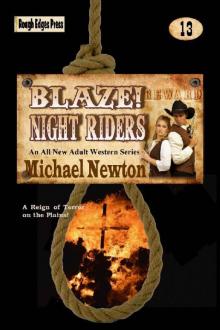 Blaze! Night Riders
Blaze! Night Riders How to Write Action Adventure Novels
How to Write Action Adventure Novels Blaze! Bad Medicine
Blaze! Bad Medicine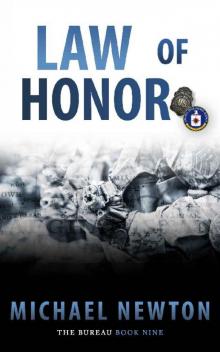 Law of Honor
Law of Honor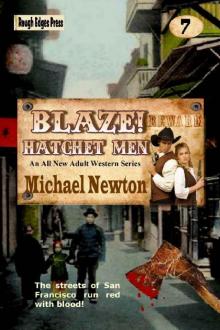 Blaze! Hatchet Men
Blaze! Hatchet Men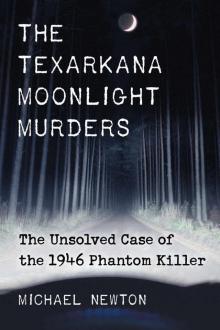 The Texarkana Moonlight Murders
The Texarkana Moonlight Murders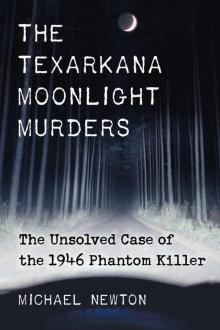 The Texarkana Moonlight Murders: The Unsolved Case of the 1946 Phantom Killer
The Texarkana Moonlight Murders: The Unsolved Case of the 1946 Phantom Killer